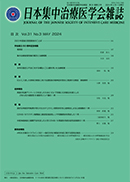Volume 31, Issue 3
Displaying 1-15 of 15 articles from this issue
- |<
- <
- 1
- >
- >|
-
2024Volume 31Issue 3 Pages 179
Published: May 01, 2024
Released on J-STAGE: May 01, 2024
Download PDF (122K)
-
2024Volume 31Issue 3 Pages 181
Published: May 01, 2024
Released on J-STAGE: May 01, 2024
Download PDF (342K) -
2024Volume 31Issue 3 Pages 182
Published: May 01, 2024
Released on J-STAGE: May 01, 2024
Download PDF (343K) -
2024Volume 31Issue 3 Pages 183
Published: May 01, 2024
Released on J-STAGE: May 01, 2024
Download PDF (345K) -
2024Volume 31Issue 3 Pages 184
Published: May 01, 2024
Released on J-STAGE: May 01, 2024
Download PDF (344K) -
2024Volume 31Issue 3 Pages 185
Published: May 01, 2024
Released on J-STAGE: May 01, 2024
Download PDF (177K)
JSICM the 50th Anniversary Commemorative Articles
-
Article type: review-article
2024Volume 31Issue 3 Pages 187
Published: May 01, 2024
Released on J-STAGE: May 01, 2024
Download PDF (159K) -
Article type: review-article
2024Volume 31Issue 3 Pages 188-193
Published: May 01, 2024
Released on J-STAGE: May 01, 2024
Download PDF (350K)
REVIEW ARTICLE
-
Article type: review-article
2024Volume 31Issue 3 Pages 195-202
Published: May 01, 2024
Released on J-STAGE: May 01, 2024
Download PDF (1478K)
ORIGINAL ARTICLE
-
2024Volume 31Issue 3 Pages 203-208
Published: May 01, 2024
Released on J-STAGE: May 01, 2024
Download PDF (372K)
CASE REPORT
-
Article type: case-report
2024Volume 31Issue 3 Pages 209-212
Published: May 01, 2024
Released on J-STAGE: May 01, 2024
Download PDF (337K)
BRIEF REPORTS
-
Article type: brief-report
2024Volume 31Issue 3 Pages 213-214
Published: May 02, 2024
Released on J-STAGE: May 01, 2024
Download PDF (223K) -
Article type: brief-report
2024Volume 31Issue 3 Pages 215-216
Published: May 01, 2024
Released on J-STAGE: May 01, 2024
Download PDF (353K) -
Article type: brief-report
2024Volume 31Issue 3 Pages 217-218
Published: May 01, 2024
Released on J-STAGE: May 01, 2024
Download PDF (267K)
COMMITTEE REPORT
-
2024Volume 31Issue 3 Pages 219-225
Published: May 01, 2024
Released on J-STAGE: May 01, 2024
Download PDF (988K)
- |<
- <
- 1
- >
- >|
